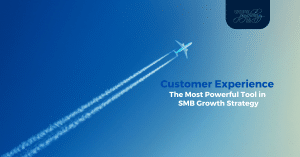Unpacking how experience transfer across industries becomes the new standard impacting CX and business results.
In today’s fast-paced world, customer expectations are constantly evolving, influenced by technological advancements and exemplary service standards set by industry leaders. The phenomenon of experience transfer being accepted as the new norm, shaped by customer experiences in different industry sectors, is becoming increasingly prominent, and one that businesses need to understand and anticipate to remain competitive.
The Evolution of Customer Expectations
Gone are the days when customers were content with basic service. Today’s consumers demand speed, convenience, and personalisation, driven largely by technological advancements and digital transformation. Companies like Amazon have revolutionised the e-commerce landscape, setting new benchmarks for efficiency and customer satisfaction. This ’Amazon effect’ has led customers to expect seamless, fast, and reliable services across all sectors, not just in online shopping. The impact is being felt in shifting customer expectations around convenience, price competitiveness, product variety and fast (often free) delivery, forcing traditional retailers to adapt or risk obsolescence.
The Impact of Cross-Industry Experience Standards Transfer
The high standards set by leading companies influence customer expectations across various industries. One such local example is Checkers Sixty60 which has redefined grocery shopping in South Africa with its promise of deliveries within 60-minutes. This rapid service has set a new and incredibly high bar for convenience, prompting customers to expect similar levels of efficiency in other areas of their lives, from food delivery to retail.
Businesses across sectors must now grapple with these heightened consumer expectations. If a customer can order via an app and get groceries delivered in an hour, they begin to expect that other services should be able to match this speed and convenience. This cross-industry experience transfer creates a ripple effect, raising the bar – and the competition – for all businesses, compelling them to innovate to keep pace. Now, a notification of an expected delivery somewhere between 08:00 and 17:00 is no longer cutting it for customers, nor not being able to track their delivery online and in real-time.
The Ripple Effect on Customer Experience
Failing to meet these heightened expectations can significantly impact customer satisfaction and loyalty. One only needs to look at the current state of play between South Africa’s top 4 retailers to understand how this failure to innovate and meet customer expectations is playing out. Customers today have little patience for delays or subpar service; they will quickly switch to competitors who can offer better experiences without batting an eyelid. Conversely, companies that rise to the challenge and meet these expectations can foster stronger customer loyalty and gain a competitive edge.
Businesses that have embraced the challenge include those integrating advanced logistics and supply chain solutions, leveraging real-time data to optimise delivery routes, and ensuring quicker service. This proactive approach not only meets customer expectations but very often exceeds them, creating memorable experiences that drive repeat business, and loyalty.
Investment in AI and Technology
Meeting and exceeding modern customer expectations necessitates robust investment in AI and technology. Predictive analytics and personalised recommendations can significantly enhance CX by providing faster, more accurate responses and anticipating customer needs. These technologies enable businesses to deliver a more personalised and efficient service, aligning with the high standards set by industry leaders, but require staying very close to what customers want, need and experience. Predictive analytics can forecast demand and help manage inventory, ensuring that products are always available when customers need them. Such investments are crucial for businesses aiming to stay competitive in an increasingly demanding market.
Case Study: Shoprite and Checkers Sixty60
Checkers Sixty60 exemplifies how adapting to changing consumer expectations can drive business growth and success. Launched in late 2019, Sixty60 promises to deliver groceries within 60 minutes, a feat that has resonated with consumers seeking convenience and speed, especially during the COVID-19 pandemic.
Shoprite’s focus on innovation, personalisation, and efficiency has significantly contributed to its growth. According to its 2023 financial results, the group reported a 16.9% increase in total sales, reaching R184.1 billion. This growth was largely driven by the success of Checkers Sixty60, which saw a 150% increase in annual sales and contributed significantly to the company’s overall performance. The business has also built its omnichannel offering for customers which ultimately results in higher customer lifetime value, as omnichannel shoppers spend 2.5x more.
By staying close to customer needs and swiftly adapting to their expectations, Shoprite has maintained its leadership position in the market. The company continuously learns from customer feedback, enhancing the Sixty60 app to improve user experience and streamline operations. This approach has not only met, but often exceeded customer expectations, fostering loyalty and driving revenue growth.
The Future of Delivery and Customer Experience
Retail delivery services are at the forefront of the evolving customer expectations. The push for faster, more efficient, and reliable delivery options is reshaping how businesses operate. Companies must leverage advanced logistics, AI, and real-time data to streamline their delivery processes and meet these new demands.
As customer expectations continue to evolve, businesses must keep their ears to the ground, and remain agile and innovative to keep pace. The influence of service delivery and experience standards being transferred across industries underscores another layer of changing expectations and the need for continuous consideration in own service design.
Crucial for business is staying very close to what customers want, need and expect. Voice of the customer programmes are one way of obtaining these insights. However, the purpose of the programmes must move beyond driving purely metrics toward insights. Using insights about customers’ expectations and experience and benchmarking beyond the company or same industry performance is the key to success. Looking at other industry standards evolving into trends (new norms) to inform constant service design improvements, holds the key to thriving and owning leadership status.
Just ask Checkers Sixty60.






